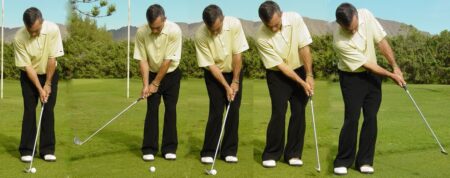
Chipping is a golf shot that is typically used when you are close to the green but not on it. The goal of a chip shot is to get the ball onto the green and close to the hole with a controlled trajectory and minimal rolling. Here are some key points and techniques to consider when chipping around the green:
- Club Selection:
- The choice of club will depend on the lie of the ball, distance you need to carry the ball and how much green you have to work with. Therefore, you might end up using any club from Sand wedge to even driver! I am a fan of keeping the ball low whenever possible (unless the shot calls for higher trajectory). I usually bring a high-lofted wedge (56/60), Gap (48/52) and mid-iron (7/8) so I have a choice of the type of shot I want to hit.
- Setup:
- Stand with your feet close together and the ball positioned off of your back foot of your stance (for most shots) or off your front foot for a higher lofted shot.
- Position your weight slightly on your front foot (left foot for right-handed golfers, right foot for left-handed golfers) – think 60/40 on front foot.
- Choke down on the grip of the club for better control.
- Create a “lower-case Y” in your set-up to help create a descending blow.
- Grip:
- Use a standard grip with your hands close together, similar to how you would grip a putter. This promotes a smoother, pendulum-like stroke.
- Ball Position:
- Place the ball off of your back foot for lower flighted shots, and front foot if you want to hit the ball higher.
- Alignment:
- Align your body parallel to the target line, just as you would for a full swing.
- Another variation is if you open up your club face (adding loft or to use bounce), you’ll want to slightly open up your stance and swing along your foot path. The club face will point towards the target, your swing path will be along the line of your feet.
- Swing:
- For the standard chip, keep your wrists firm and use a minimal wrist hinge during the swing.
- Use a pendulum-like motion, with your arms and shoulders doing most of the work.
- The length of your backswing should be short, and the follow-through should be of similar length.
- Maintain a consistent tempo and rhythm throughout the swing.
- The longer the shot, the more you’ll involve your trail knee towards the target and slightly rotating your chest as well towards the target. It shouldn’t just be an arms motion.
- Weight Transfer:
- Maintain your weight on your front foot throughout the swing, and avoid leaning back.
- Impact:
- Strike the ball with a slight descending blow to ensure clean contact.
- Make contact with the ball first and then take a small divot or brush the grass after impact.
- Trajectory Control:
- To hit the ball higher, open the clubface slightly at address.
- To keep the ball low, keep the clubface square or slightly closed at address.
- The lower the shaft angle, the higher the shot. The more vertical the shaft angle, the lower the shot. Thus you would be farther from the ball if trying to hit a higher shot because you would have to drop down the shaft angle at address. And closer to the ball with a more vertical shaft thus promoting a lower flighted shot.
- Practice:
- Spend time practicing chipping from different lies and distances to develop a feel for different shots.
- Practice your chipping to develop consistency and accuracy around the green.
Remember that chipping is about precision and control. It’s crucial to practice and gain confidence in your chipping technique to improve your short game and lower your golf scores. Chipping, pitching and putting accounts for nearly 65% of the game of golf. Its imperative you practice this often overlooked portion of the game.
For more information or to schedule a lesson, contact Dan at bettergolfinstruction.com
